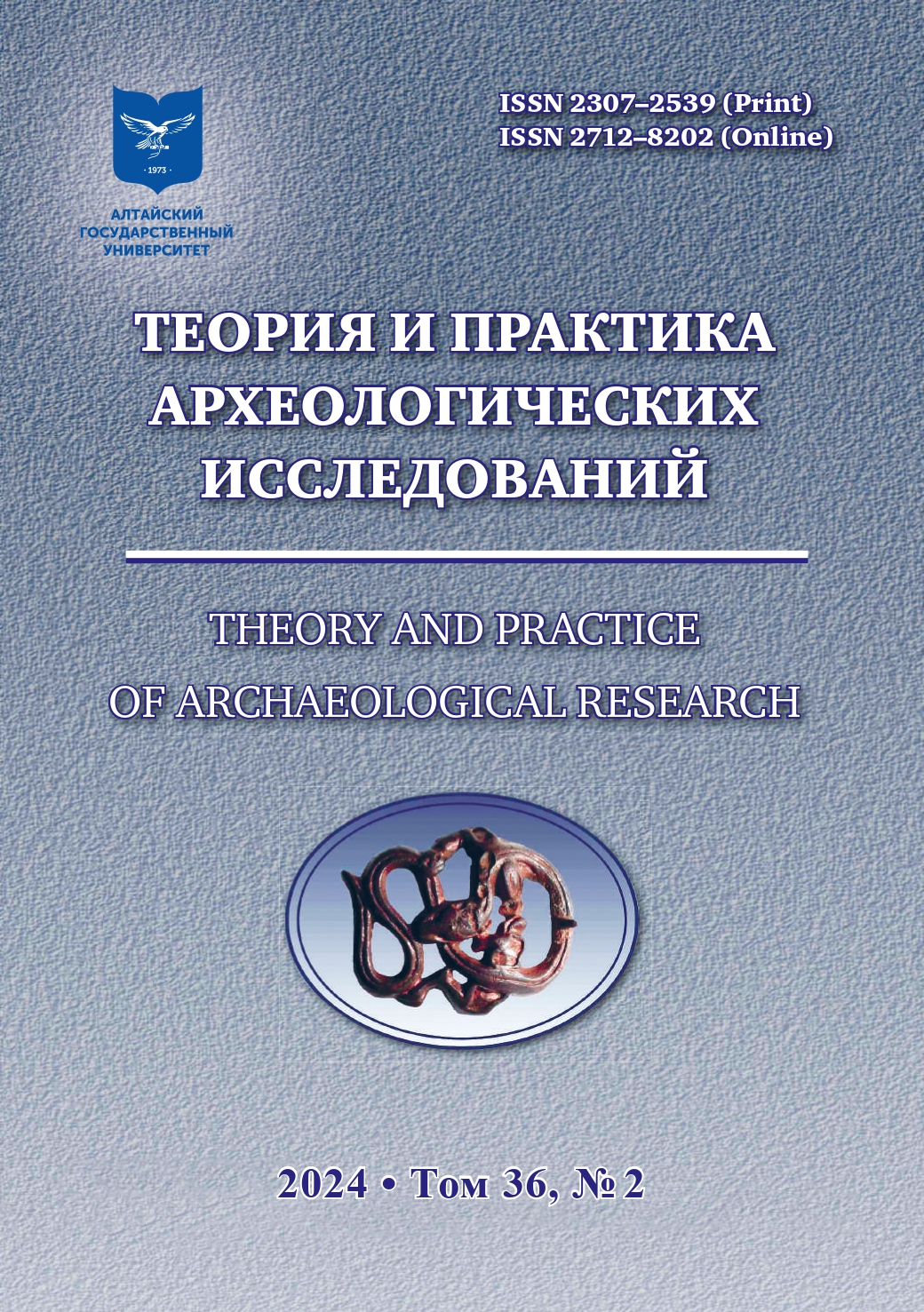ISLANDS IN THE OCEAN OR THE OCEAN OF ISLANDS: THE STONE AGE OF SOUTHEAST ASIA
Abstract
The data from archaeology and physical anthropology strongly indicate that all stages in the appearance of early hominids in the island area of Southeast Asia, and the subsequent occupation of this territory by Homo sapiens, are linked to the specific climatic conditions, as well as fluctuations in the sea level. This is due to the need to cross water spaces and to actively develop marine resources. The Early Paleolithic period in the region was characterized by the presence of several hominin species — Homo erectus, dating back over 1 million years BP, as well as Homo floresiensis and Homo luzonensis, after 700,000 BP. The arrival of Homo sapiens was recorded no later than 50,000 years ago, at which point it had already spread to New Guinea, the Solomon Islands, and Australia. 8,000 years ago, the migration of people speaking Austronesian languages began from the island of Taiwan, which soon spread throughout Southeast Asia and absorbed the previous Late Paleolithic population. The appeal of the island concept is clearly evident in the search for new research methods that integrate efforts and data from various scientific fields. This has led to the emergence of new terms, including nissology, or the study of islands. This term is actively used in ecological, geographical, and historical discourse, but it is still met with some resistance among archaeologists, who prefer the more familiar term “Island Archaeology”.
Downloads
Metrics
References
Vakhoneev V.V. Maritime Archaeology: Тextbook for the Universities. Moscow : Yurajt, 2024. 205 p. (In Russ.)
Derevianko A.P. Three Global Human Migrations in Eurasia. V. 1: The Origin of Man and Its Peopling of Southwest, South, East, Southeast and Caucasian. Novosibirsk : Izd-vo Inta arheologii i etnografii SO RAN, 2015. 612 p. (In Russ.)
Portnova A.A., Tabarev A.V. Harimau Cave and Peculiarities of the Pre-Neolithic Burial Traditions in Indonesia. In: Problems of Archaeology, Ethnography, Anthropology of Siberia and Adjacent Territories. Vol. 29. Novosibirsk : Izd-vo In-ta arheologii i etnografii SO RAN, 2023. Pp. 275–279. (In Russ.)
Tabarev A.V. History of Studies of the Stone Age of Indonesia: Early Holocene Toala (Toalean) Industry, Sulawesi. In: Problems of Archaeology, Ethnography, Anthropology of Siberia and Adjacent Territories. Vol. 28. Novosibirsk : Izd-vo In-ta arheologii i etnografii SO RAN, 2022. Pp. 305–310. (In Russ.)
Tabarev A.V., Ivanova D.A. Art of ancient cultures of the Pacific basin: Experience of “local styles” definition. Problemy istorii, filologii, kul’tury = Problems of history, philology and culture. 2019;2:201–214. (In Russ.)
Tabarev A.V., Kanomata Y. “Tropical Package”: Peculiarities of the Lithic Industries of the Most Ancient Cultures, Coastal Ecuador, Pacific Basin. Arheologiya, etnografiya, antropologiya Evrazii = Archaeology, Ethnology and Anthropology of Eurasia. 2015;3:64-76. (In Russ.)
Tabarev A.V., Patrusheva A.E. Neolithic of the Insular Southeast Asia: Peculiarities, Hypothesis, Discussions. Teoriya i praktika arheologicheskih issledovanij = Theory and Practice of Archaeological Research. 2018;1:165–179. (In Russ.)
Bellwood P. First Islanders: Prehistory and Human Migration in Island Southeast Asia. Victoria: Wiley-Blackwell, 2017. 384 p.
Boomert A., Bright A.J. Island Archaeology: In Search of a New Horizon. Island Studies Journal. 2007;2(1):3–26.
Brumm A., Aziz F., van den Bergh G., Morwood M.J., Moore M.W., Kurniawan I., Hobbs D.R., Fullagar R. Early stone technology on Flores and its implications for Homo floresiensis. Nature. 2006;441:624–628.
Brumm A., Bulbeck D., Hakim B., Burhan B., Oktaviana A.A., Sumantri I., Zhao Jian-xin, Aubert M., Sardi R., McGahan D., Saiful A.M., Adhityatama S., Kaifu Y. Skeletal remains of a Pleistocene modern human (Homo sapiens) from Sulawesi. PLoS ONE. 2021;16(9). e0257273.
Dawson H. Island Archaeology. In: Encyclopedia of Global Archaeology. Springer, Cham, 2019. https://doi.org/10.1007/978-3-319-51726-1_3280-1
Depraetere C. The Challenge of Nissology: A Global Outlook on the World Archipelago, Part I: Scene Setting the World Archipelago. Island Studies Journal. 2008;3(1):3–16.
Forestier H., Grenet M., Borel A., Celiberti V. The Lithic Productions of Indonesian Archipelago. Journal of Lithic Studies. 2017;4(2):231–303.
Garau A.O. Toponymy and Nissology: an Approach to Defining the Balearic Islands’ Geographical and Cultural Character. Island Studies Journal. 2017;12(1): 243–254.
Hay P. A Phenomenology of Islands. Island Studies Journal. 2006;1(1):19–42.
Hung Hsiao-chun. History and Current Debates of Archaeology in Island Southeast Asia. In: Encyclopedia of Global Archaeology. Springer, Cham, 2019. https://doi.org/10.1007/978-3-319-51726-1_3373-1
Hung Hsiao-chun. Asia, Southeast: Islands. In: Encyclopedia of Archaeology. Vol. 4. Elsiever, 2024. P. 243–253.
Hung Hsiao-chun, Cheng-hwa T., Zhenhua D. Preceramic Riverside Hunter-Gatherers and the Arrival of Neolithic Farmers in Northern Luzon. Antiquity. 2022;96(388):848–867.
Ingicco T., Semah F., Zhou Y., Semah A.-M., Forestier H. The Early Lithic Productions of Island Southeast Asia: Traditions or Convergences? L’Anthropologie. 2022;126(1):102997.
Kakazu H. Nissology: A Study of Island Sustainability Focusing on the Islands of Okinawa. Tokyo : Next Publishing Authors Press, 2021. 315 p.
McCall G. Nissology: A Proposal for Consideration. Journal of the Pacific Society. 1994;17:93–106.
Moles A.A. Nissonologie ou science des iles. L’Espace geographique. 1982;11(4):281–289.
Newman K., Hakim B., Oktaviana A.A., Burhan B., McGahan D., Brumm A. The Missing Deposits of South Sulawesi: New Sources of Evidence for the Pleistocene/Holocene Archaeological Transition. Archaeological Research in Asia. 2022;32:100408.
Ono R., Pawlik A., Fuentes R. Island Migration, Resource Use, and Lithic Technology by Anatomically Modern Humans in Wallacea. In: Pleistocene Archaeology — Migration, Technology, and Adaptation. Intechopen, 2020. P. 85–111.
Ronstrom O. Island Words, Island Worlds: The Origins and Meanings of Words for ‘Islands’ in North-West Europe. Island Studies Journal. 2009;4(2):163–182.
Samper-Carro S.C., O’Connor S., Mahirta, Kealy S., Shipton C. Talking Dead. New Burials from Tron Bon Lei (Alor Island, Indonesia) Inform on the Evolution of Mortuary Practices from the Terminal Pleistocene to the Holocene in Southeast Asia. PLoS One. 2022;17(8):e0267635.
Shipton C., O’Connor S., Jankowski N., O’Connor-Veth J., Maloney T., Kealy S., Boulanger C. A new 44,000-year Sequence from Asitau Kuru (Jerimalai), Timor-Leste, Indicates Long-Term Continuity in Human Behavior. Archaeological and Anthropological Sciences. 2019;11:5717–5741.
Simanjuntak T. The Western Route Migration: A Second Probable Neolithic Diffusion to Indonesia. In: New Perspectives in Southeast Asian and Pacific Prehistory. Canberra : ANU Press, 2017. P. 201–211.
Solheim W.G. II Archaeology and Culture in Southeast Asia: Unraveling the Nusantao. Quezon City : The University of the Philippines Press, 2006. 316 p.
Spriggs M. Are Islands Islands? Some Thoughts on the History of Chalk and Cheese. In Islands of Inquiry. In: Colonisation, Seafaring and the Archaeology of Maritime Landscapes. Ed. by G. Clark, F. Leach, S. O’Connor. Canberra : Australian National University Press, 2008. P. 211–226.
Takamiya H. Nissology, Island Archaeology, and the Archaeology of Ryukyus (1). South Pacific Studies. 2021–2022;42(1, 2):49–72.
Van Heteren A.H., de Vos J. Stone Implem History of the Discoveries. Comptes Rendus Palevol. 2012;11(2–3):181–189.
Voyages of Discovery. The Archaeology of Islands. Ed. by S.M. Fitzpatrick. Westport/London: Praeger, 2004. 328 p.
Copyright (c) 2024 А.В. Табарев

This work is licensed under a Creative Commons Attribution 4.0 International License.
Theory and Practice of Archaeological Research is a golden publisher, as we allow self-archiving, but most importantly we are fully transparent about your rights.
Authors may present and discuss their findings ahead of publication: at biological or scientific conferences, on preprint servers, in public databases, and in blogs, wikis, tweets, and other informal communication channels.
Theory and Practice of Archaeological Research allows authors to deposit manuscripts (currently under review or those for intended submission to ABS) in non-commercial, pre-print servers such as ArXiv.
Authors who publish with this journal agree to the following terms:
- Authors retain copyright and grant the journal right of first publication with the work simultaneously licensed under a Creative Commons Attribution License (CC BY 4.0) that allows others to share the work with an acknowledgement of the work's authorship and initial publication in this journal.
- Authors are able to enter into separate, additional contractual arrangements for the non-exclusive distribution of the journal's published version of the work (e.g., post it to an institutional repository or publish it in a book), with an acknowledgement of its initial publication in this journal.
- Authors are permitted and encouraged to post their work online (e.g., in institutional repositories or on their website) prior to and during the submission process, as it can lead to productive exchanges, as well as earlier and greater citation of published work (See The Effect of Open Access).








2.jpg)




